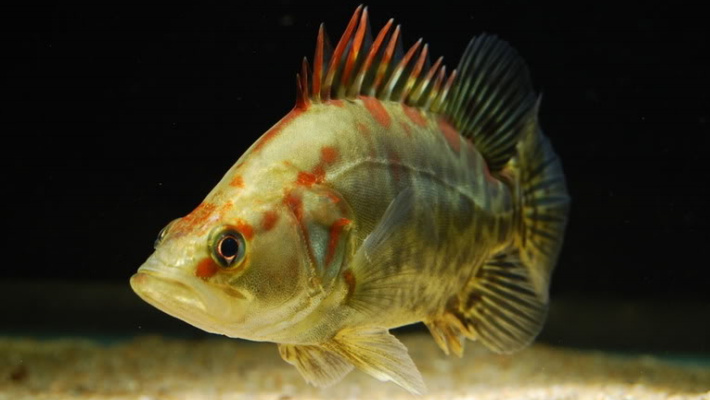|
Freshwater
percid (Percidae) fish can be divided into the two groups depending on type of
their activity and sensory equipment. European perch,
Perca fluviatilis, American yellow
perch, Perca flavescens, and numerous
American darters (Etheostoma)
demonstrate the diurnal type of activity (first of all of the feeding
activity), are visually guided fish and, thus, may be included in the first
group.
In
laboratory and natural conditions, both perches usually do not eat immobile as well as dead
food and demonstrate relatively weak responses to food odors or their absence. According
to Mirza et al. (2003), an aqueous brine shrimp (Artemia spp.) extract (5 g of frozen shrimp in 150 ml of distilled
water for 1 hour) induces searching movements in P. flavescens. Both perches, however, do not go practically into
the minnow traps baited with the animal lures (in contrast to cyprinid, cobitid and other fish).
In
aquarium, blinded P. fluviatilis may find
the pieces of earthworms using olfactory and gustatory systems (Wunder, 1927).
But convergence of perch with brown trout, Salmo
trutta, on sensory system utilization is incorrect.
Both
species of euryhaline
Percarina, Azov percarina, P. maeotica, and common percarina, P. demidoffi, use vision in day when hunting for zooplankton and
lateral line system at night when hunting for preyfish (Kanaeva, 1956).
Roberts and
Winn (1962) have tested utilization of the senses in feeding behavior of johnny
darter, Etheostoma nigrum, using live
worms (Tubifex), dead worms and crushed worm solutions. It is shown that
darters prefer live worms and respond slightly to an olfactory stimulus. Daugherty
et al. (1976) have studied responses of six species of darters (E. gracile, E. spectabile, E. whipplei, E.
radiosum, E. collettei and E.
punctulatum) to visual and olfactory cues of worms. It is revealed that
olfactory cues (water from live Tubifex) alone are not sufficeint to stimulate
complete feeding behaviour in darters, both in clear or muddy waters.
Fountain
darter, Etheostoma fonticola,
respond to live aquatic microinvertebrates and ignore immobile items (Shenck & Whiteside, 1977).
Darters or
longperches of Percina genus are also
diurnally active and feed on live macroinvertebrates (Greenberg, 1991). Percina
are more mobile than Etheostoma and spent most time above the bottom.
Another
group is formed by percids with the twilight or nocturnal type of feeding
activity with the well developed chemosensory and lateral line systems. Three
Europen zanders or pikeperches, Stizostedion
lucioperca , S. volgensis and
estuarine pikeperch S. marinus, both
North American zanders, walleye S.
vitreus and sauger S. canadensis,
all species of Gymnocephalus genus
(such as common ruffe Gymnocephalus
cernuus, Donets ruffe G. acerina, striped
ruffe G. schraetser and other), all
species of Zingel genus (such as Z. zingel, Z. streber, Z. balcanicus and
other) and sculpin-perch Romanichthys
valsanicola (single species of Romanichthys
genus) belong to this group. Three last genera are represented in temperate Europe, except common ruffes which occupy mainly boreal
areas and are active intruders.
Responses of walleye S.
vitreus to natural and artificial food odors are well documented (Rottiers & Lemm, 1985).
The olfactory
sensitivity of ruffe G. cernuus to
food odors (extracts of Chronomidae larvae) is about 10-2 g l-1
that is less than the olfactory sensitivity of cyprinid fish (Kasumyan et al.,
2003).
Laboratory
experiments in the dark using infrared video equipment show (Jassen, 1997) that
ruffe G. cernuus detect Daphnia
magna (Crustacea: Daphnidae) and mayfly Hexagenia limbata
(Insecta: Ephemeridae) larvae at the greater distance than yellow perch P. flavescens moving also faster whilst
searching for prey. Because of their sensory abilities, ruffe feed
predominantly at night, reducing in parallel the competitive
interference from perch P. fluviatilis
(Schleuter &
Eckmann, 2006).
Skin of
percid fish contains alarm pheromone that is documented in yellow perch P. flevescens, common ruffe G. cernuus and other species. Realesing
in the water, this pheromone induces in small (planktivorous) perch an
avoidance behaviour, whereas large (piscivorous) perch display feeding
behaviour (Mirza et al., 2003; Harvey & Brown,
2004).
Basic References
Daugherty
C.H., Daugherty L.B., Blair A.P. 1976. Visual and olfactory stimuli in the
feeding behavior of darters (Etheostoma) inhabiting clear and muddy water. Copeia 1976, 380-382
Greenberg L.A. 1991. Habitat use and feeding behavior of thirteen
species of benthic stream fishes. Environmental
Biology of Fishes 31, 389-401
Harvey M.C., Brown G.E. 2004. Dine or dash?: Ontogenetic shift in the response of
yellow perch to conspecific alarm cues. Environmental Biology of Fishes 70, 345-352
Kanaeva
I.P. 1956. Diurnal changes in the feeding of
the Azov percarina. Journal of
Ichthyology 7, 71-84
Kasumyan A.O., Marusov E.A., Sidorov S.S. 2003. Feeding behavior of the ruffe Gymnocephalus cernuus triggered by olfactory and
gustatory stimulants. Journal of
Ichthyology 43, S247-S254
Janssen J. 1997. Comparison of response distance to prey via the
lateral line in the ruffe and yellow perch. Journal
of Fish Biology 51, 921-930
Mirza R.S.,
Fisher S.A., Chivers D.P. 2003. Assessment of predation risk by juvenile yellow perch (Perca flavescens): responses to alarm cues from conspecifics and
prey guild members. Environmental Biology of Fishes 66, 321–327.
Roberts
N.J., Winn H.E. 1962. Utilization of the senses in feeding behavior of the
johnny darter, Etheostoma nigrum. Copeia 1962, 567-570
Rottiers D.V., Lemm C.A. 1985. Movement of
underyearling walleyes in response to odor and visual cues. The Progressive Fish-Culturist 47, 34-41
Schleuter
D., Eckmann R. 2006. Competition
between perch (Perca fluviatilis) and
ruffe (Gymnocephalus cernuus): the advantage of
turning night into day. Freshwater Biology 51, 287-297
Shenck
J.R., Whiteside B.G. 1977. Food habits and feeding behavior of the fountain
darter, Etheostoma fonticola
(Osteichthyes: Percidae). The Southwest
Naturalist 21, 487-492
Wunder W.
1927. Sinnesphysiologische Untersuchungen über die Nahrungsaufnahme bei
verschiedenen Knochenfischarten. Zeitschrift
für vergleichende Physiologie 6, 67-98
| 







 SUBSCRIBE
SUBSCRIBE


